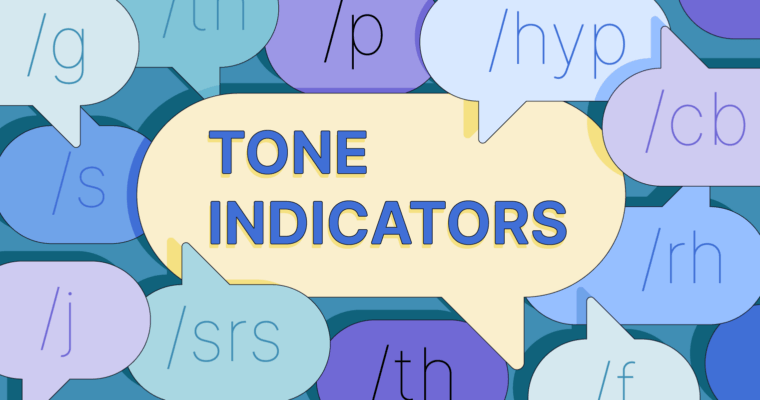
Have you ever accidentally offended someone over text message? It happens. Unlike in speech, tone can be hard to convey and detect in written communication. Once you hit send, it’s up to the recipient to interpret your tone.
This is where tone indicators come into play. Tone indicators are simple symbols or letter combinations that show what sentiment a message is meant to express. Tone indicators are used when communicating over text message and in chat rooms, forums, dating apps, and other platforms.
If you’ve never used tone indicators before, keeping track of them can be difficult. Here, we’ve gathered the most popular tone indicators into a handy guide for understanding and using them effectively.
Whether you’re new to tone indicators or simply looking to enhance your understanding, this article will help you incorporate tone indicators into your everyday online vernacular.
What is a tone indicator?
A tone indicator is a notation that signals the emotional intent behind a written message. Tone indicators can be useful in certain online conversations where it can be difficult to interpret the tone of a message.
Some people also use emojis, emoticons, abbreviations, acronyms, or bigrams to convey sentiment. These can be things like a smiley face emoji (🙂), “LOL,” or “XO.” This article focuses primarily on the most complex tone indicators: abbreviations.
Using tone indicators can help prevent misunderstandings when communicating online. They can also promote clearer and more effective communication and signal a potentially appropriate response.
When to use a tone indicator
It’s important to consider the feelings of the person receiving your message and how your words may be perceived when using tone indicators. When in doubt, it’s better to err on the side of caution and use a tone indicator to ensure clear, respectful communication.
Some everyday situations where tone indicators are helpful include the following:
- When communicating online or via text message
- During discussions of sensitive or controversial topics
- In situations where you think your words may be misinterpreted
- When using humor or sarcasm in a text that may not be immediately apparent
- When you’re expressing empathy or concern for someone’s feelings
Tone indicators aren’t necessary for these types of writing:
- Academic writing
- Professional communication
- Messages with close friends or family members who are familiar with your communication style
- Instances when the tone is obvious from the context of the message
How to use tone indicators
Add the abbreviation at the end of a sentence to use a tone indicator in written communication. Tone indicators shouldn’t be used to replace clear and direct communication.
Usually, the tone indicator is preceded by a slash. Sometimes, tone indicators can also be written within parentheses or preceded by a dash.
Here are some ways you might see tone indicators written:
- /j
- (jk)
- -j
25 tone indicators
Here are some examples of tone indicators, what they stand for, and what they each mean.
1 /c
Copypasta
This is used to indicate text that frequently gets copied and pasted across multiple internet chats.
2 /cb
Clickbait
Sensationalized content whose main purpose is to attract and generate clicks and views on a website or social media platform is often followed by this tone indicator.
3 /f
Fake
This indicates that the sender believes someone else’s comment wasn’t sincere or genuine.
4 /g or /gen
Genuine
Often used with a question, this indicates that someone is asking a question sincerely.
5 /hj
Half-joking
“Half-joking” means that a comment that appears to be serious is meant to be a joke. It’s also used when a comment that appears to be a joke has serious intent.
6 /hyp
Hyperbole
This is used by senders to indicate that they are exaggerating or by commenters to note that they believe someone else is exaggerating.
7 /ij
I’m joking or Inside joke
Often used to soften a frank comment that may not be well received, this indicates that it was meant as a joke. When used in a group chat, this tone indicator can refer to a joke shared only among certain group members.
8 /j
Joking
This indicates that a comment is meant as a joke. It may be interchanged with “/jk” (just kidding).
9 /l or /ly
Lyrics
When a sender quotes song lyrics in a message, they’ll usually use this tone indicator.
10 /lh
Lighthearted
Similar to “/j” (joking), this may follow a comment meant to be lighthearted or cheerful.
11 /li
Literally
Indicates that a comment should be taken literally as opposed to “/m” (metaphorically), “/j” (joking), or “/hj” (half-joking).
12 /lu
A little upset
When someone is upset by a comment made by someone else, they’ll use this to indicate their feelings.
13 /m
Metaphorically
This indicates that a comment should be taken metaphorically or symbolically as opposed to “/l” (literally).
14 /nbh or /nsb
Nobody here or Not subtweeting
This means “not directed at anybody here.” It’s used when someone is venting or posting vaguely but not directing their message at anybody in the space where they’re sending it.
15 /neg or /nc
Negative connotation
This indicates that a sender intends their comment or message, which could be interpreted negatively, to be taken seriously.
16 /neu
Neutral
When a sender wants their message to be taken neutrally, they’ll end it with this tone indicator.
17 /nm
Not mad
This shows that the sender isn’t upset or angry.
18 /nsrs
Nonserious
This is used when a sender doesn’t intend for their comment to be taken seriously.
19 /pos or /pc
Positive connotation
A sender uses this tone indicator to indicate that their message is meant to be positive.
20 /p
Platonic
This is often used when a message expresses affection but is meant to be taken platonically rather than romantically or sexually.
21 /rh or /rt
Rhetorical question
When a commenter or sender means for their question to be taken rhetorically or when a commenter is responding to someone who didn’t realize the original post was rhetorical, they’ll often use this tone indicator.
22 /s
Sarcastic
This is used when a sender means for their message or comment to come across sarcastically.
23 /srs
Serious or Seriously
When a sender wants their comment to be taken seriously, they’ll often use this tone indicator.
24 /t
Teasing
This indicates a comment is meant to come across jokingly or teasingly.
25 /th
Threat
When a sender wants their comment to be taken as a threat, they’ll add this.
Sentences with tone indicators
/l example
“Every little thing gonna be alright! /l”
This comment, which includes a song lyric from “Three Little Birds,” by Bob Marley and the Wailers, essentially means “Don’t worry!”
/p example
“I couldn’t live without you /p.”
This message conveys that the sender appreciates having this person in their life but in a platonic way.
/hj example
“If you insist on sending me cat videos every day, I will block you /hj.”
This use of “half-joking” indicates that the sender doesn’t want to receive so many cat videos (serious), and is mad enough about it to block the person (joking).
/neg example
“I think it’s mean when you make fun of Kelly. /neg.”
Using “negative” in this way makes it clear the sender is serious.
/rt example
“Do you even lift, bro? /rt”
A message like this is a question asked jokingly that is not meant to elicit a response.
Tone indicator FAQs
What is a tone indicator?
A tone indicator is a symbol or word used in written communication to convey the sentiment of a message. Some popular tone indicators include “/s” for sarcastic, “/j” for joking, and “/gen” for genuine.
How do tone indicators work?
Tone indicators are added at the end of a sentence to indicate the sentiment behind a message. They are preceded by a slash and usually consist of a short abbreviation that indicates a common emotional intent.
When should you use them?
You may want to use a tone indicator in casual online or text conversations where emotion can be difficult to interpret. They’re also useful when discussing emotionally charged topics.






